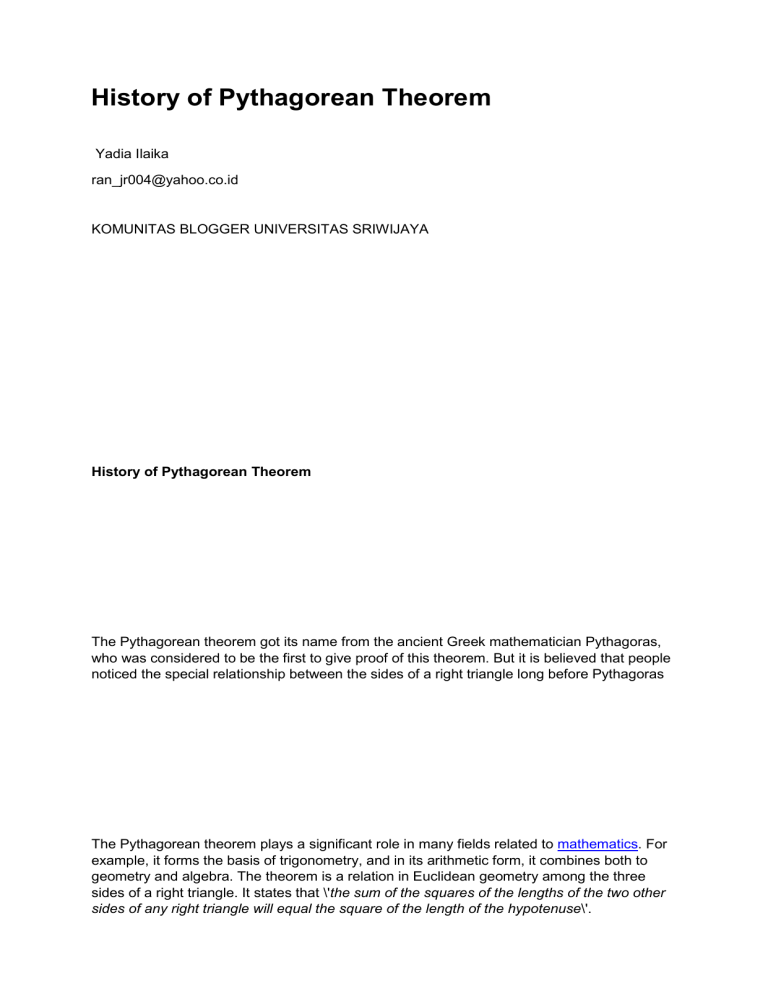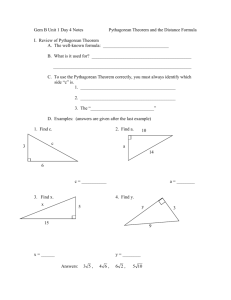History of Pythagorean Theorem - Blog Unsri

History of Pythagorean Theorem
Yadia Ilaika ran_jr004@yahoo.co.id
KOMUNITAS BLOGGER UNIVERSITAS SRIWIJAYA
History of Pythagorean Theorem
The Pythagorean theorem got its name from the ancient Greek mathematician Pythagoras, who was considered to be the first to give proof of this theorem. But it is believed that people noticed the special relationship between the sides of a right triangle long before Pythagoras
The Pythagorean theorem plays a significant role in many fields related to mathematics . For example, it forms the basis of trigonometry, and in its arithmetic form, it combines both to geometry and algebra. The theorem is a relation in Euclidean geometry among the three sides of a right triangle. It states that \' the sum of the squares of the lengths of the two other sides of any right triangle will equal the square of the length of the hypotenuse \'.
Mathematically, the theorem is usually written as: a
2
+ b
2
= c
2
- where a and b represent the lengths of the two other sides of the triangle and c represents the length of the hypotenuse.
History
The history of the Pythagorean theorem can be divided as: knowledge of Pythagorean triples, the relationship among the sides of a right triangle and their adjacent angles, and the proofs of the theorem. Around 4000 years ago, the Babylonians and the Chinese were aware of the fact that a triangle with the sides of 3, 4 and 5 must be a right triangle. They used this concept to construct right angles and designed a right triangle by dividing a long string into twelve equal parts, such that one side of the triangle is three, the second side is four and the third side is five sections long.
Around 2500 BC, the Megalithic monuments in Egypt and Northern Europe comprised of right triangles with integer sides. Bartel Leendert van der Waerden hypothesizes that the
Pythagorean triples were identified algebraically. During the reign of Hammurabi the Great
(1790 – 1750 BC), the Mesopotamian tablet Plimpton 32 consisted of many entries closely related to Pythagorean triples. In India (8th - 2nd century BC), the Baudhayana Sulba
Sutra comprised of a list of Pythagorean triples, a statement of the theorem and the geometrical proof of the theorem for an isosceles right triangle.
Pythagoras (569–475 BC), used algebraic methods to construct Pythagorean triples.
According to Sir Thomas L. Heath, there was no ascription of the theorem for nearly five centuries after Pythagoras lived. However, authors like Plutarch and Cicero attributed the theorem to Pythagoras in such a way that the attribution was widely known and accepted. In
400 BC, Plato established a method for finding Pythagorean triples which blended both algebra and geometry. Around 300 BC, in the Euclid\'s Elements, the oldest existing axiomatic proof of the theorem is presented. The Chinese text Chou Pei Suan Ching written between 500 BC and 200 AD had the visual proof of the Pythagorean theorem or \'Gougu theorem\' (as known in China) for the (3,4,5) triangle. During the Han Dynasty (202 BC
– 220 AD), the Pythagorean triples appear in the Nine Chapters on the Mathematical
Art along with the mention of the right triangles. The first recorded use of the theorem was in
China as \'Gougu theorem\', and in India as the \'Bhaskara theorem\'.
However, it is not yet confirmed whether Pythagoras was the first person to have found the relationship between the sides of the right triangles, as no texts written by him were found.
Nevertheless, the theorem has still got his name credited to it.
By
Kanika
Khara





